[Review] Armored Core VI: Fires of Rubicon
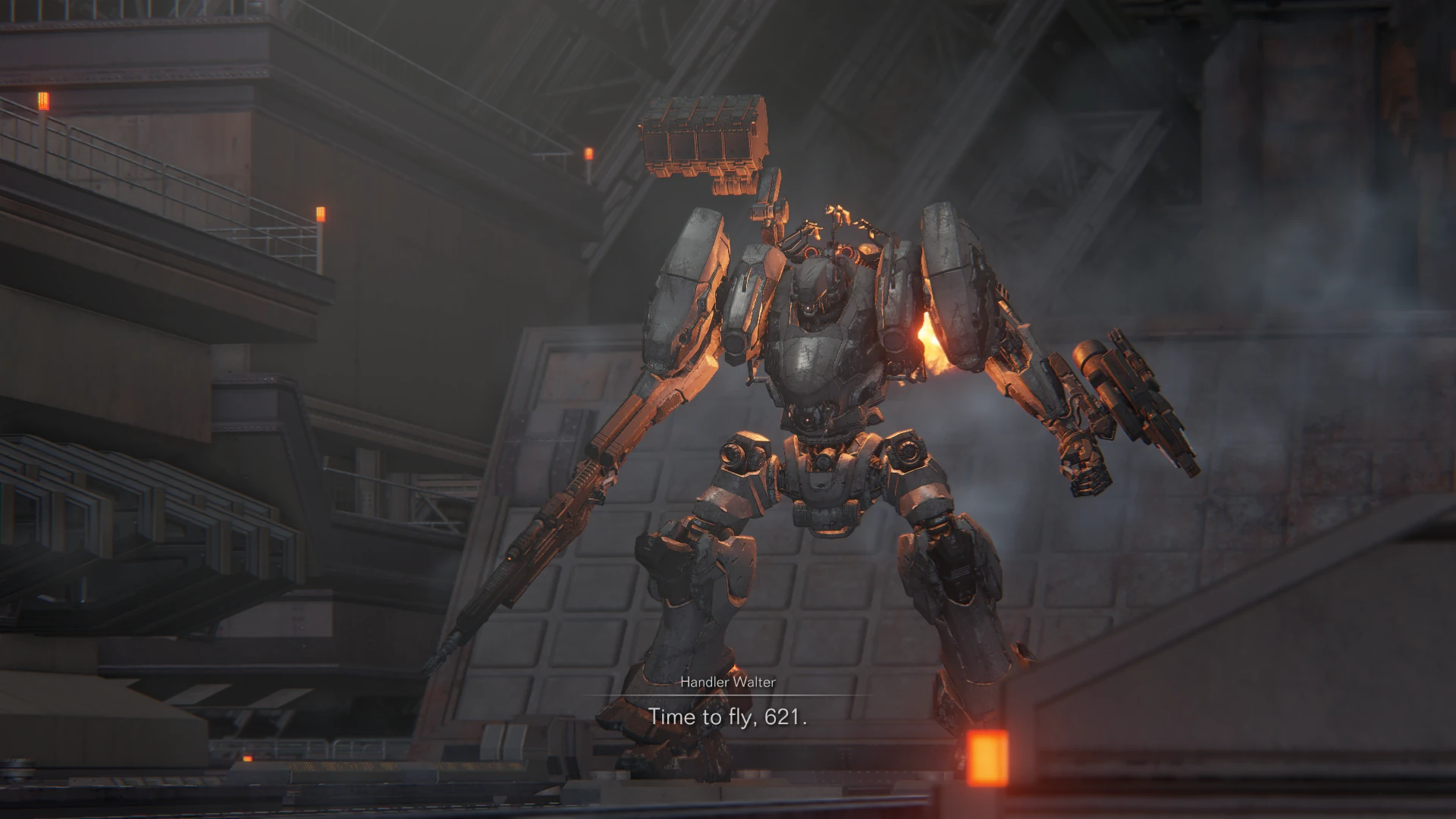
And bloody hell does it stick the landing.
Originally FromSoft’s vanguard franchise after King’s Field fell to the wayside, the tepid reception of the fifth generation games and the smash hit success that Dark Souls had proven to be saw the Armored Core series benched for an entire decade. Now, with the Souls trilogy out in full and a series of spin-offs having had their own time in the limelight, it was only natural that the series would make its return and what a return it is. Staying true to the core mechanics of Armored Core while taking a few thematic and structural developments from some of their newer games, Armored Core 6: Fire of Rubicon, is a stellar return to form and probably one of the strongest entries in the series, but I’ve got my own niggles with some of the choices that were made. So, let’s assemble the full story of just what lies at the Core of this Armor. Six.
Gameplay
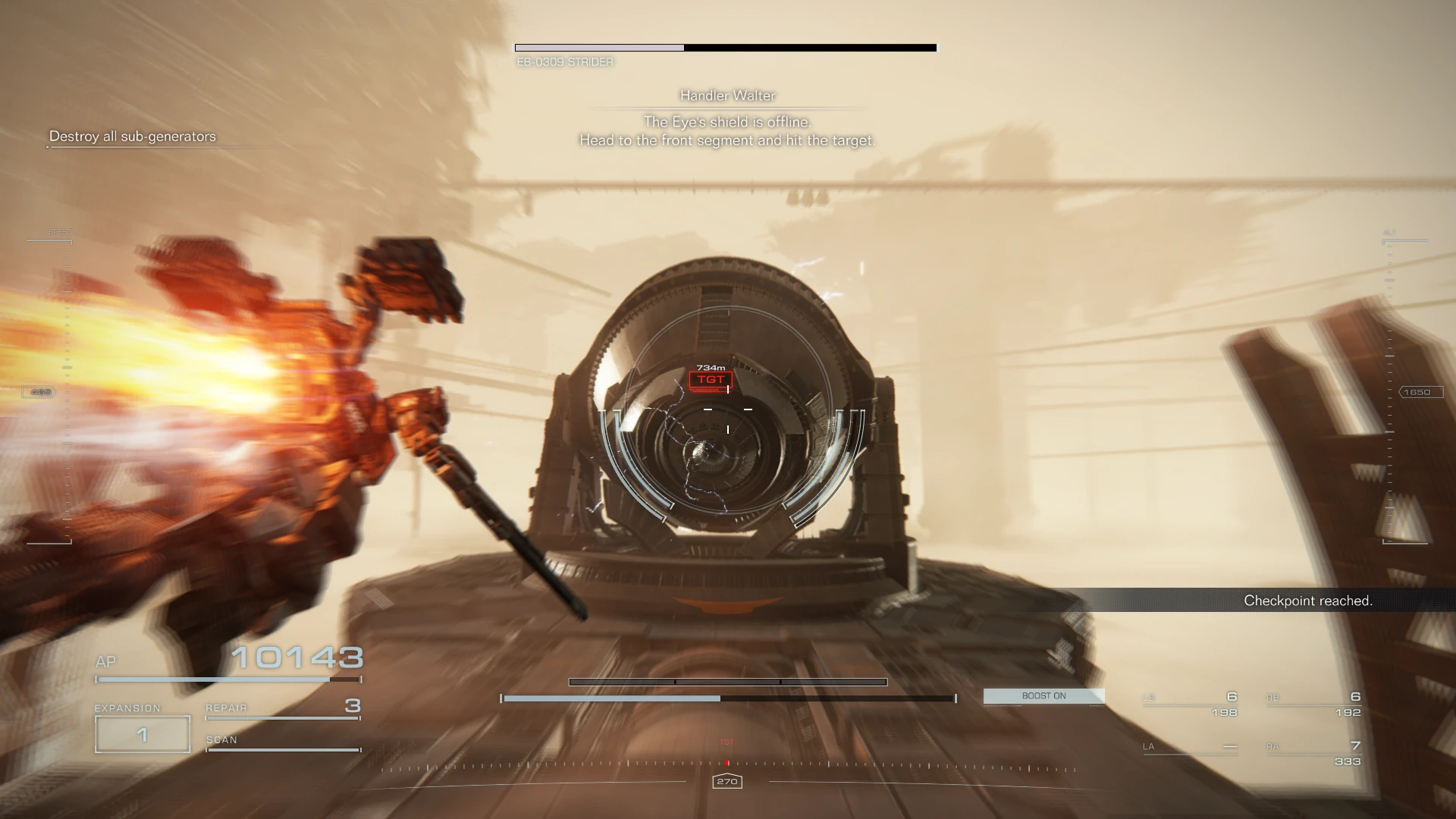
Enemies come in all shapes and sizes.
To those who have played an Armored Core game before, the quickest way to describe how AC6 plays is that it takes the core of 3rd gen’s mechanics, adds a lot of the movement tech from 4th gen, leans heavily on 5th gen for how it controls, and finally they slapped Sekiro’s stagger system onto it to give it some unique seasoning. Right, that should be enough for this section then-
Nah, let’s get into it. So for those of you who’ve never touched an AC game in your life, Armored Core 6 is a weighty third-person shooter/action game where you play as the pilot of an Armored Core, a giant super modular combat mecha deployed for missions where a more specialized approach than sending in mass produced units is required. Despite your massive size, powerful boosters allow you to remain in fluid motion and take advantage of vertical and unconventional approaches to engaging enemies, making for a very fluid and dynamic gameplay experience.
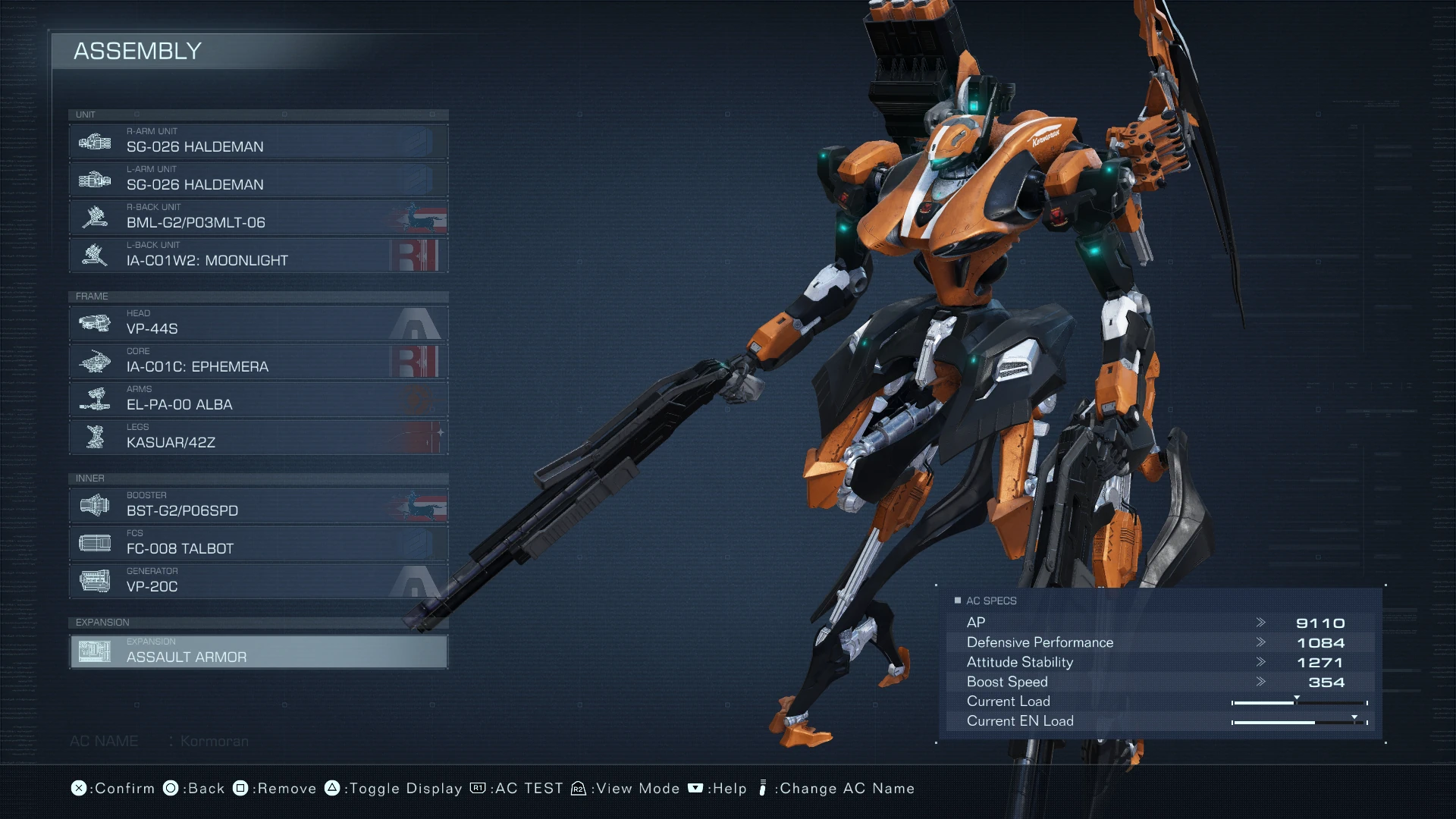
An AC is defined by the parts that make it.
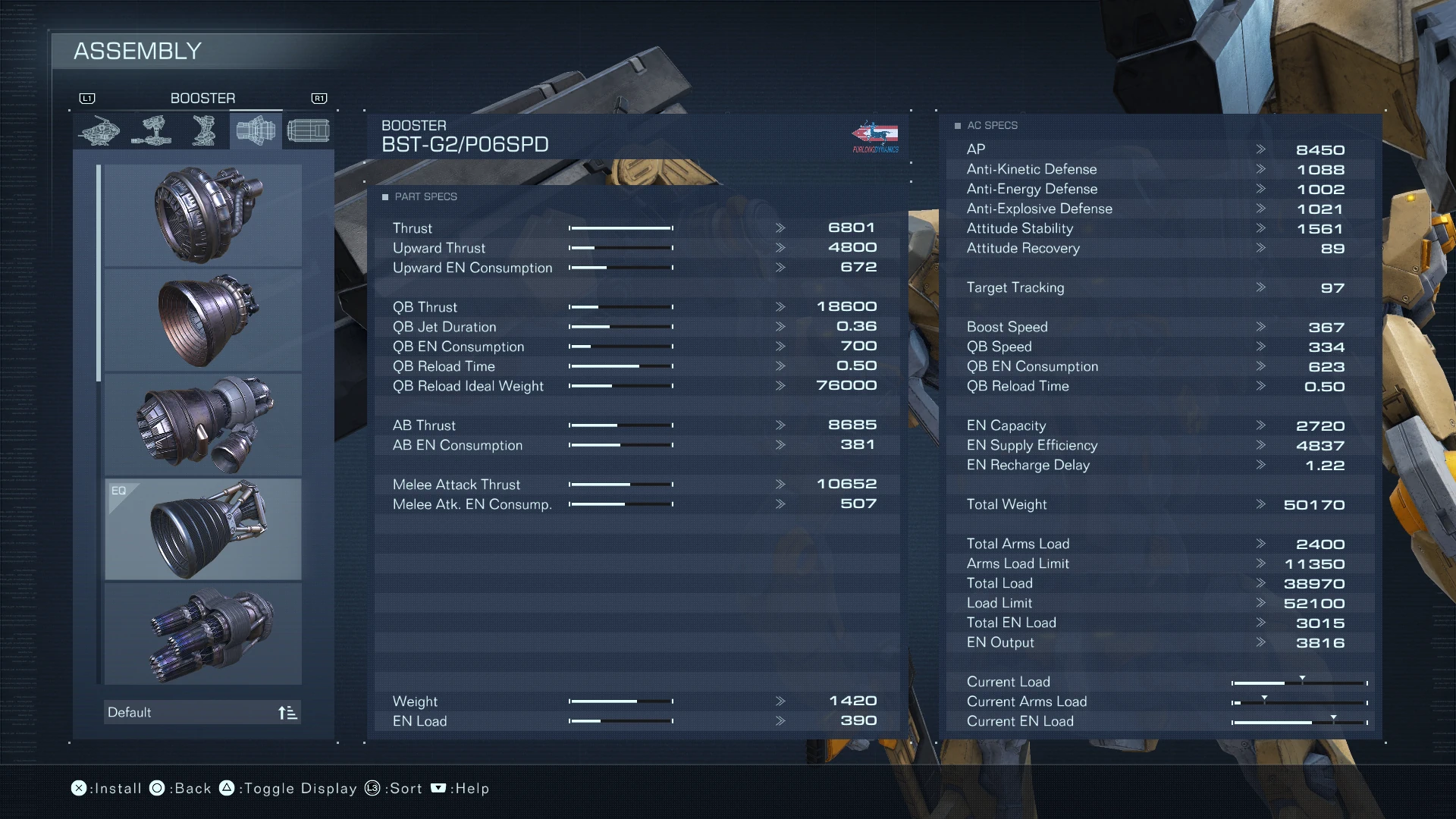
Every part affects a number of aspects of your AC's performance.
Before we touch on the actual core combat, let’s take a look at one of the key parts underpinning the entire experience – AC Assembly. Assembly is where the player gets to really decide just how they want to play – weapons will be the key parts that define just how the player’s AC engages enemies; frame parts define the AC’s appearance and core stats such as its defences, the maximum weight it can support, and its overall health; internal parts let the player tune the underlying systems of the AC such as its boost speed, energy supply, and ranges its most effective at; and then the Core Expansion gives the player a choice of a number of utility abilities or a super attack to finish off their build. On top of these diverse customization options is a fantastic paint job editor and robust decal system that’s the best the series has ever seen thus far.
As far as actual part variety within each category goes, FromSoft have taken a much more “narrow but deep” approach, usually having only 1-3 options for each subcategory of part (as in like, there’ll be 1-3 options for each different type of legs) but having these options be particularly distinct from one another. Taking the tank treads leg-type for example – there are 3 options available; the first is your classic large bulky blocky tank chassis which is slow and bulky and has fantastic defences and load capacity, but then the second option is a shockingly fast and nimble set of threads that fits into more of a midweight category and is perfect for super agile ground fighters, and then the third option is another radical departure from the tank stereotype that’s more of a strange hover-dragster (and a callback to one of the old hover legs from the games when that was still a leg type) that gives the player’s AC and incredibly slow descent speed so long as they maintain any horizontal movement.
While it means your more aesthetic and granular options that would have been available in the previous games are far less readily available, it does help every part feel far more impactful, especially when even something as simple as changing your head piece to one with better stability control or scanning ability can have a tangible effect on how you approach combat.
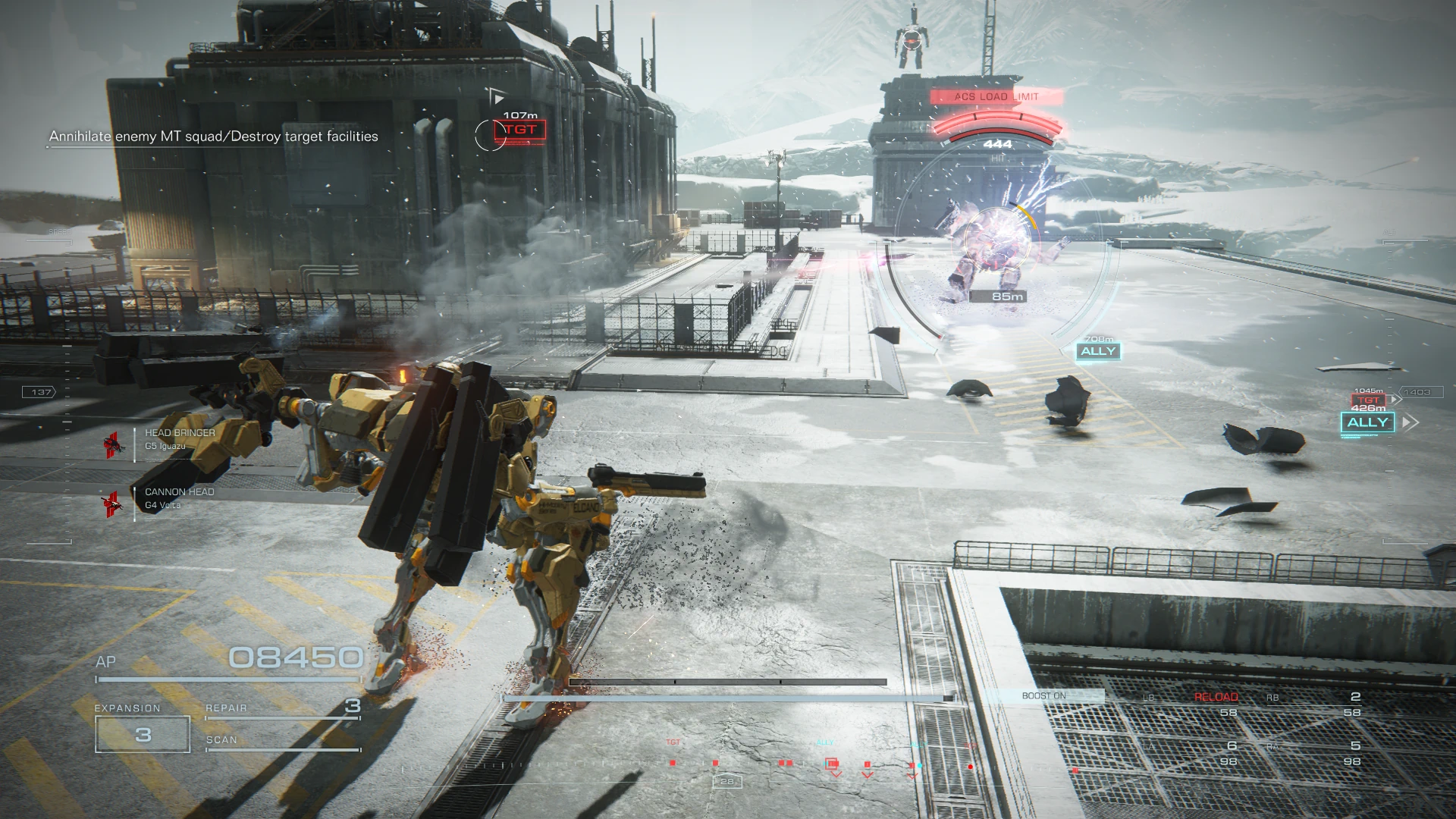
MTs (Muscle Tracers, don't ask) are the most common enemy category players will encounter.
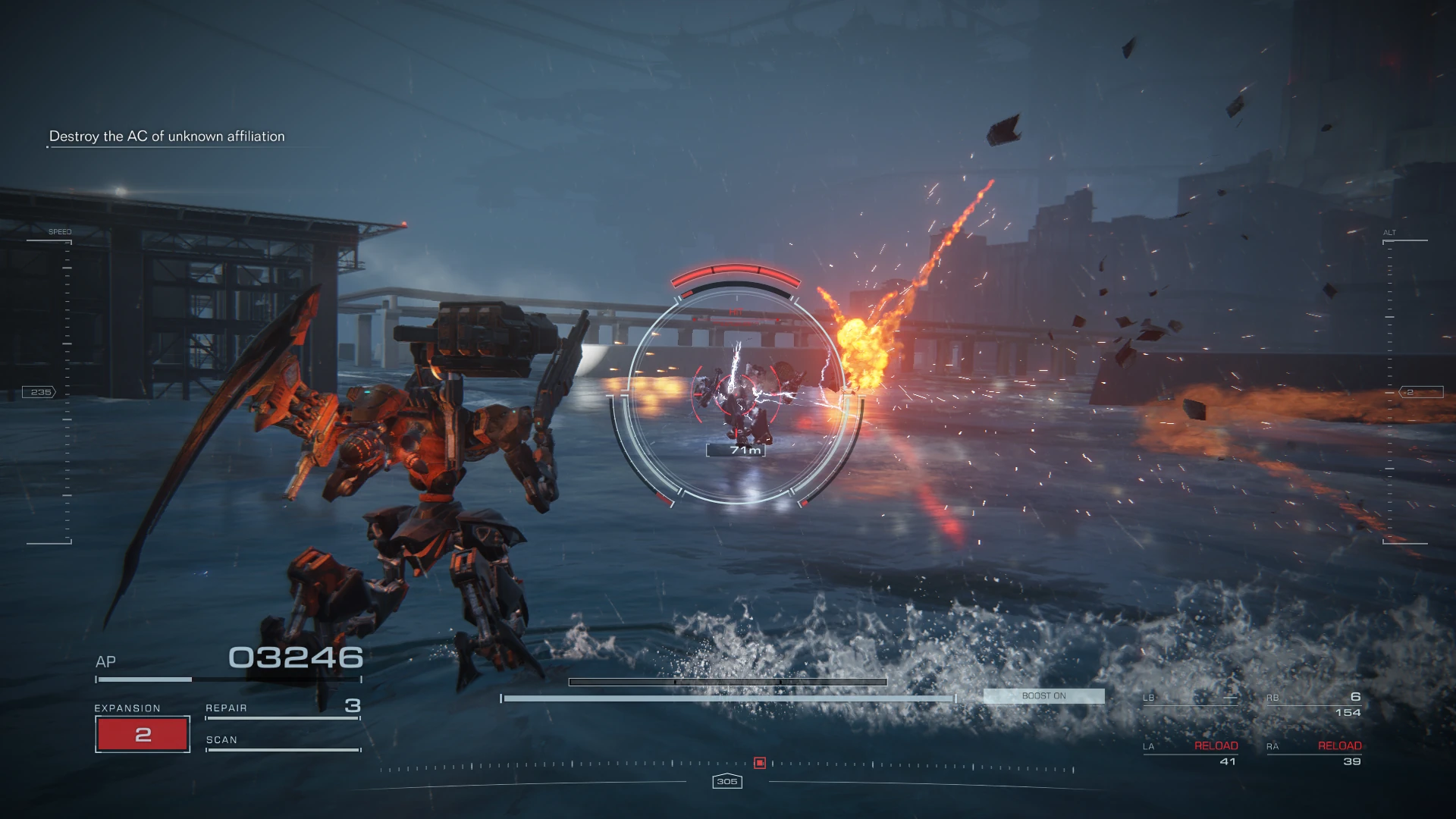
AC duels are perhaps some of the most frenetic and satisfying fights in the game.
Alright then, enough nattering on about the customization, let’s talk about the actual gameplay. Sticking to its classic mission-based structure, a general playthrough of the game will consist of about 42 missions with a variety of objectives and challenges to be faced. The pre-mission briefing will (usually) give the player an idea of what to expect so they can prepare their AC accordingly and then they’re sent off into the battlefield. As well as your standard missions, the series staple Arena makes a return, offering players a number of fun 1v1 battles and bios for a bunch of strange quirky little dudes as is its tradition. It’s always great to take a break from the story and just enjoy some good ol’ 1v1 AC fights to climb your way up the arena ladder whenever you unlock the next batch of challengers.
A radical change in this game is the addition of far more intricately designed boss battles which will often serve as the set-piece of a chapter, obviously incorporating a fair bit of what they’ve learned in the past few years pumping out Souls games. Unlike in the past where unique boss enemies where often either comically easy or annoying and gimmicky, From have achieved a fantastic balance here and created compelling boss battles which test both your skills and build alike, and replaying a boss that once caused you hours of grievance only to wash them in less than a minute because you’ve improved that much is an incredibly satisfying feeling.
As mentioned previously, ACs are weighty and massive but the moment you toggle the boosters on you glide across the ground as smooth as anything. Combat is a fast-paced affair where you have to constantly stay in motion and keep your movements dynamic and unpredictable to throw off the enemy’s fire control system, using your quickboosts to violently jerk yourself out of the enemy’s line of fire and aerial leaps to confound their sense of direction entirely. As is the norm with the series, targeting an enemy isn’t a matter of accurately keeping your crosshair on the enemy’s model, but rather just ensuring you keep them on screen and within the distance your equipped FCS is effective so it can automatically lock and calculate where it should be firing for you, a system which is more fitting than ever given how much more of a spiralling dogfight AC vs AC combat can be in this game.
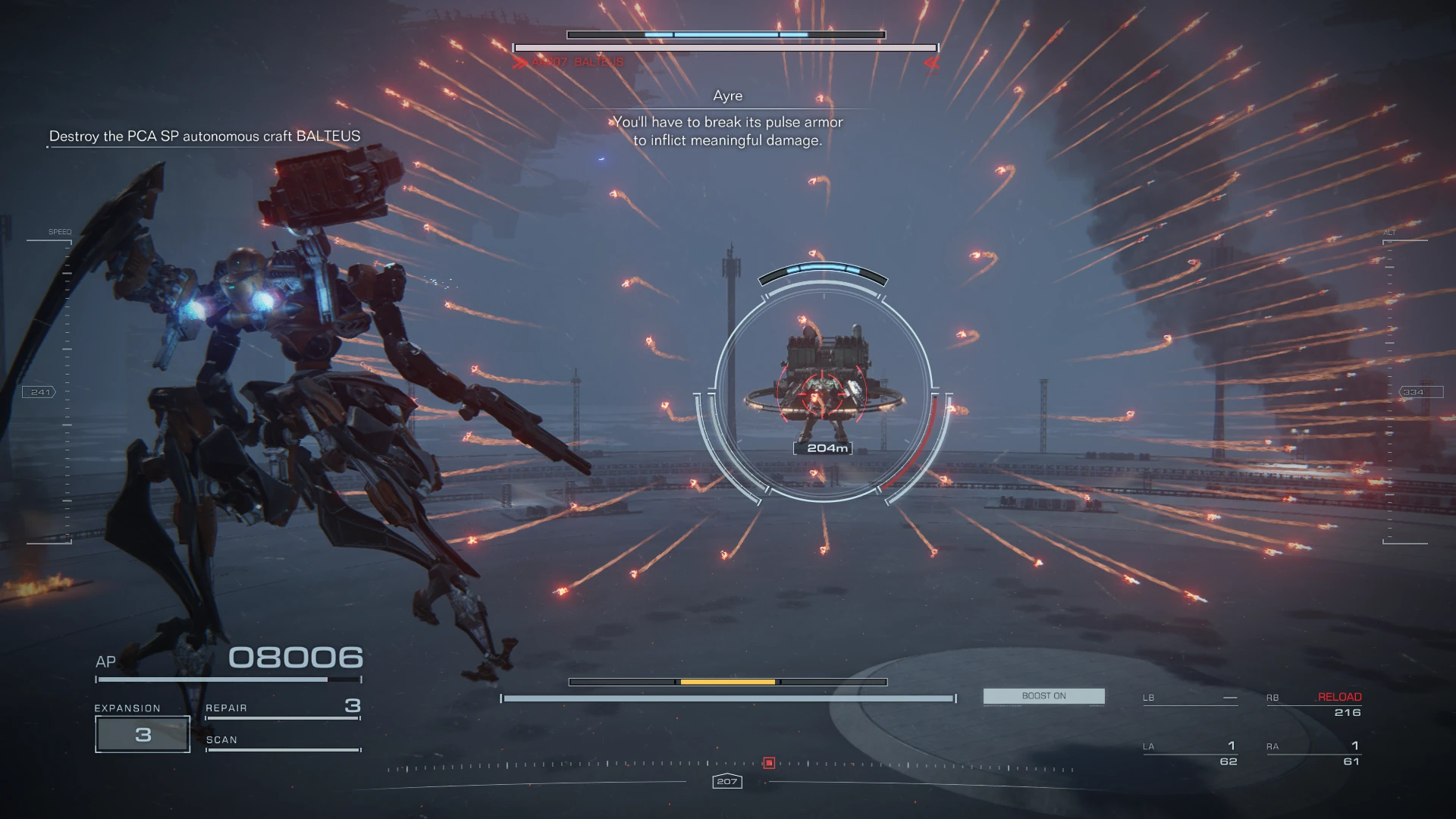
Boss fights are both an exciting spectacle and an engaging challenge.
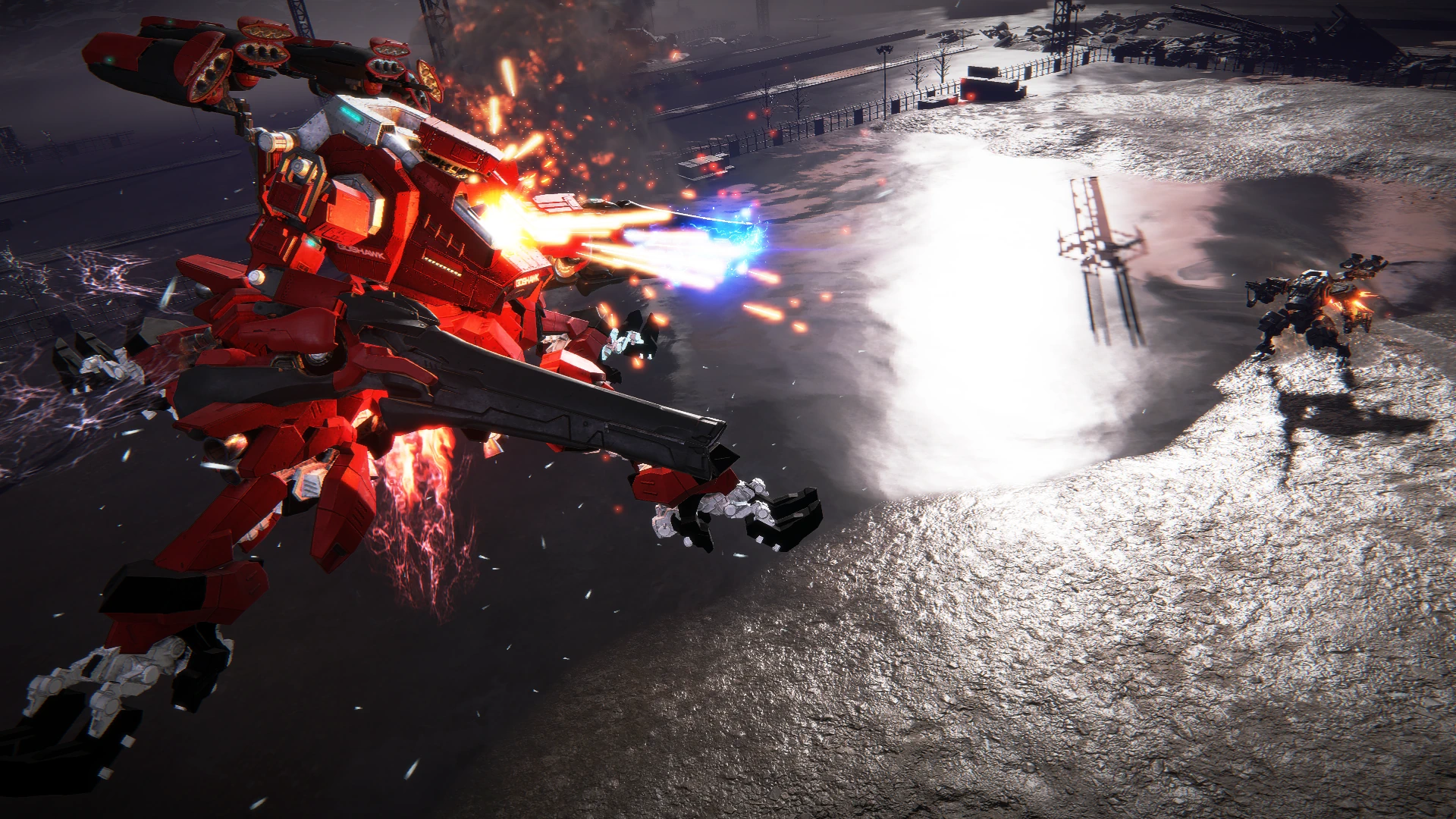
A wide variety of build options are open to accomodate many playstyles.
The game also offers two toggles for this aiming system now – one is Manual Aim, a system which must be unlocked and has only really niche use for sniping beyond the range the standard FCS will lock-on at, and the other is the “Hard Lock”, available from the get go. This toggle locks the player’s camera onto their target of choice will move to continue tracking the target if they try to move out of view. There was a lot of doomsaying about this on the lead-in to the game and cries of ‘casualizing’ the game or ‘catering to the Dark Souls crowd’ but having played the game quite extensively I’d disagree with that. When using the Hard Lock, the FCS tracks less effectively than it does in the standard “Soft Lock” and by its very nature it’s more of a detriment if the player is in any situation other than a 1v1 (which is most of the game!), so I find it primarily useful as a tool for close-range duels where accuracy is less of a concern and you want to focus more on your manoeuvres and predicting your enemies moves in turn.
On the topic of of close-quarters combat, let’s talk about the weapons. Goodness fucking grief have melee weapons never felt better than this within the series. From the pulse blade with its smooth, tracking combos, the laser blade with its wide, crowd-clearing sweeps, to the incredibly violent straight-striking lunges of the pilebunker, melee combat has reached its all-time peak within the series. That’s not to say guns aren’t also feeling great – rifles have a fantastic meaty punch to their fire, linear rifles’ charged shots punch through the sound barrier with a satisfying blast, and laser weaponry has a distinct sizzle that makes it really feel like their air is burning in the wake of their shots. Much like the other parts, weapons also fall into the philosophy of ‘narrow but deep’ – there are only 3 assault rifles, for example, but the options are a balanced and consistent standard rifle, a slow-firing and punchy battle rifle, or a burst-fire assault rifle which can easily shred simple enemies and better punish agile ACs when you catch them slow down for a moment.
However, one of the more radical changes is the addition of a posture/stagger system in the form of ACS (Attitude Control System). As well as their Armour Points (AP, which is your health), player and enemy alike all possess an ACS gauge which will fill up as attacks hit them, with kinetic and explosive damage inflicting more impact than energy weapons. When the bar is filled, the target is staggered and immediately ceases all momentum and freezes up momentarily while taking multiplied damage for the next few seconds. I was very on the fence about this mechanic initially, and ultimately I think I’ve found myself on the negative side in regards to my thoughts on it. While it feels pretty good in boss battles to whittle down their poise and reach that moment where you can take out a weighty chunk of their AP with your offensive, in normal gameplay and especially in AC vs AC combat (which is historically my favourite thing in these games!) I find it feels particularly disruptive to the flow of combat and the fact that you essentially HAVE to engage with it to inflict meaningful damage with a lot of weapons has soured me on it. Combining this with the Ideal Range/Effective Range stats which sees many weapons become pretty much useless at anything beyond mid range has made this a very close and personal game for any builds that don’t primarily use missiles. Kinda makes me wonder what the point of that one FCS that focuses exclusively on long range is.
Oh yeah there’s also “OS Tuning”, which is a pretty bland system that allows you to unlock new features by spending chips won through arena participation, but come the second playthrough you’ll earn enough chips to unlock everything and it ultimately amounts to little more than an arbitrary skill tree system. Whatever I guess.
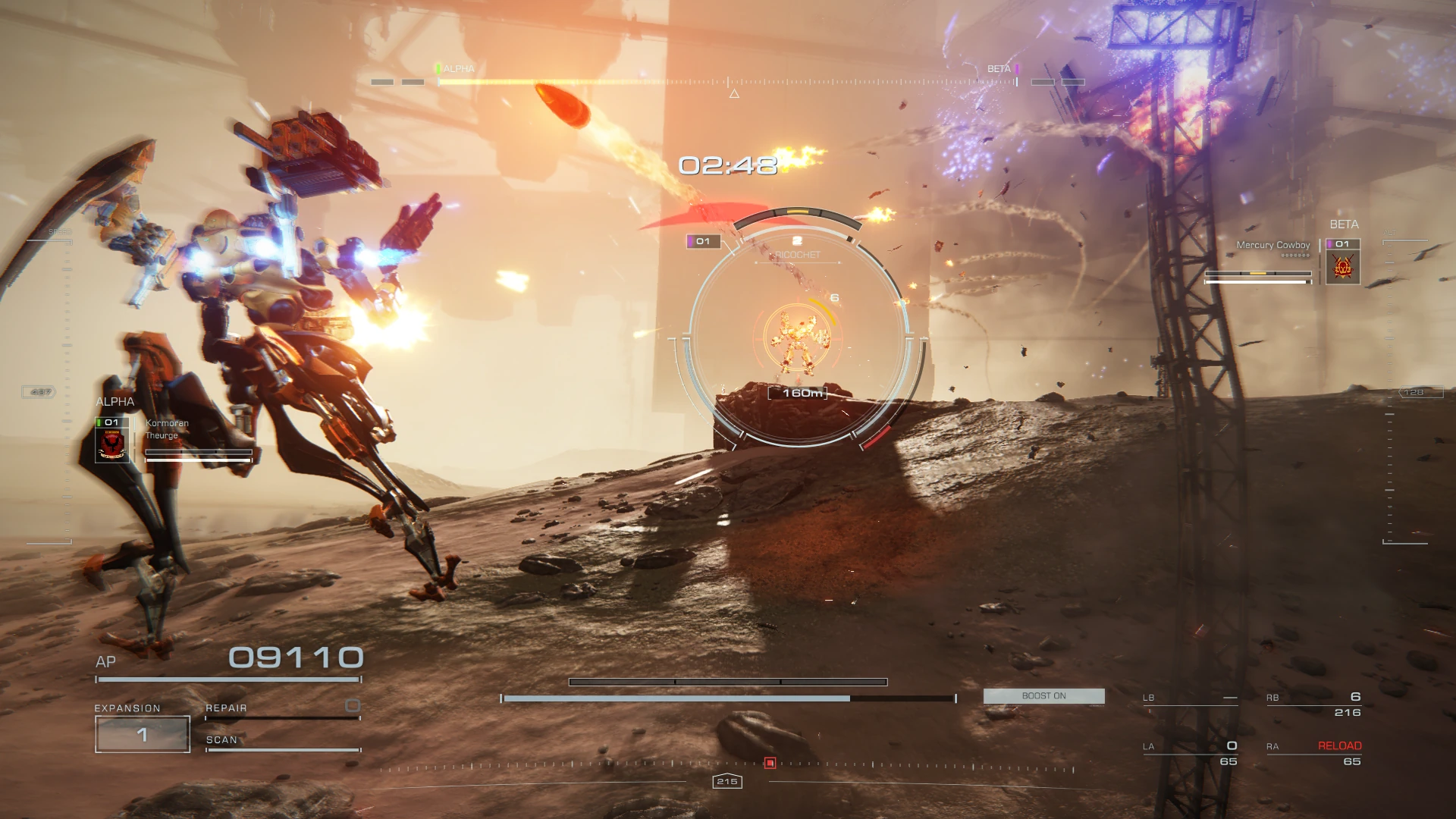
PvP duels are fast-paced violent affairs.
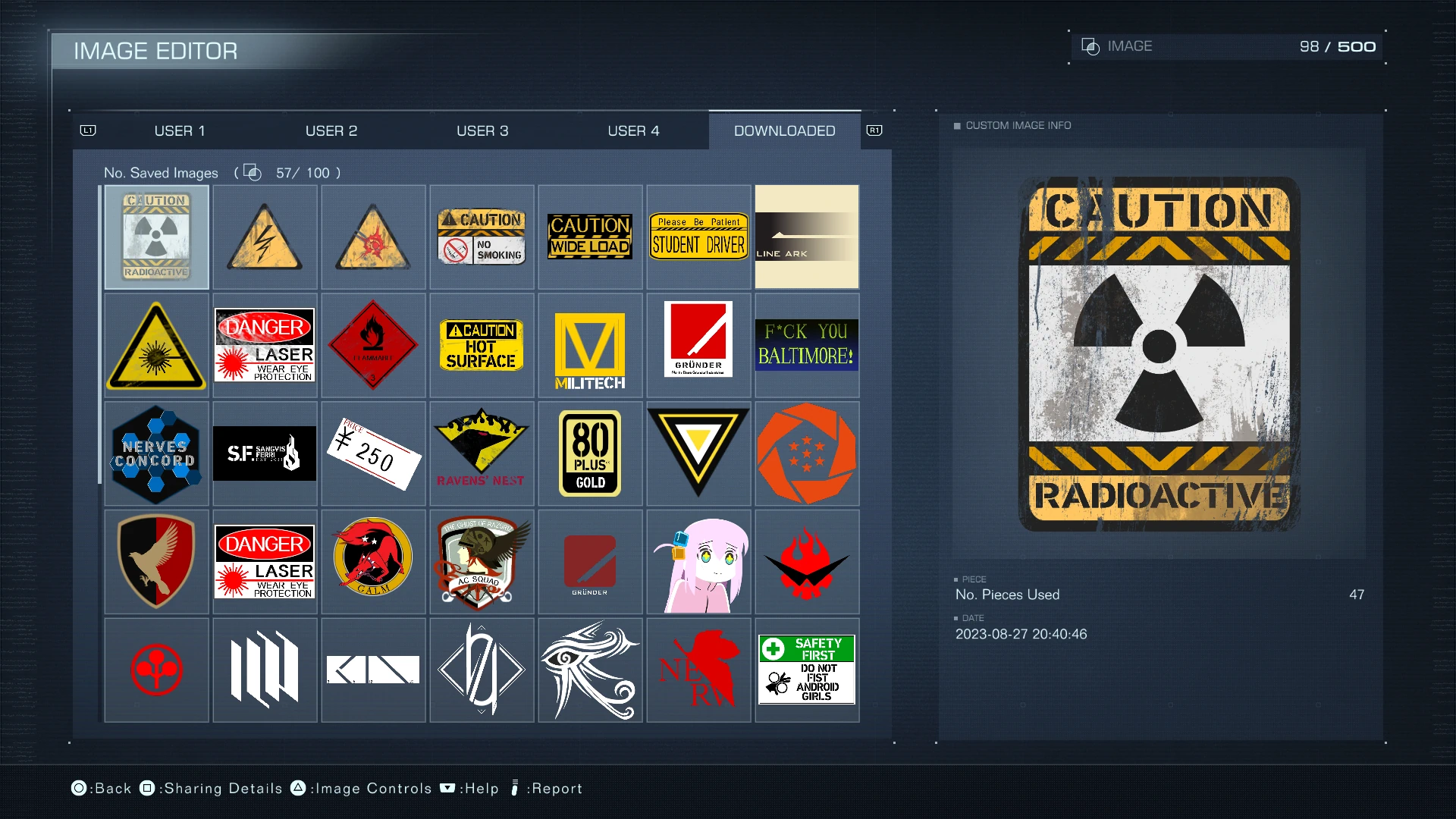
Sharing functionality allows players to share various custom decals and designs.
Let’s (finally) wrap this up by talking about multiplayer features then! Complimenting the fantastic customization and decal creation features I mentioned above is a robust and simple share feature that lets players upload their AC data or custom decals and allow other players to download them with a simple code. It’s a great feature for a game with so many options for creativity and can certainly help inspire other players to get a little creative themselves.
On the more direct front of multiplayer, we have a pretty standard PvP affair in which players can either engage in a best-of-3 1v1 duelling mode, or a 3v3 timed deathmatch with respawning (Strange that there’s no ability to play 2v2 though – why’d they jump that one?). On the plus side, this is probably the sanest lobby system we’ve seen in a FromSoft game in a long time – inviting friends through Steam just works; there’s a varied selection of 9 pretty unique maps; a robust system for either setting matchups to rotate winners, losers, or just let you assign ‘em manually; and spectating works pretty cleanly (it’d be nice if you could toggle a hard lock on the other player’s AC though). As for the actual PvP gameplay? Well, it’s fine really. I haven’t had any particular problems with the netcode beyond some bugs which means some graphics don’t always render correctly (core expansion abilities and certain endgame weapon effects), but otherwise you can just get in their and duel your friends pretty effectively.
There are two primary problems I have with the PvP; the first is that uh, it’s a bit lacking in variety. Smashing your face against each other is plenty of fun for a while, but without any different game modes to vary things up and a lack of any matchmaking option as of the time of writing, it can get a bit stale. Secondly, the balance can be insanely wack. The double Zimmerman build is certainly well-known across the internet for their insanely high damage AND stagger values, but other builds such as the double stun needle setup which instantly melts about 80% of a staggered AC’s health on hit or tetrapod builds with 4 missile launchers that float up at maximum altitude and rain down hell upon their helpless opponents below can be quite painful to fight. Of course, matters of balance are always subject to change, and a patch even saw a number of basic kinetic weapons like rifles getting some much needed buffs, but as it currently is overall it makes for a pretty uninteresting PvP landscape.
Well, that was a long ol' section, but there’s a lot to talk about. AC6 does so much right and is has an incredibly compelling gameplay loop that keeps pulling me back in despite those systems which I’m not a fan of. It makes me wish FromSoft still released optional ‘Regulation’ formats which radically altered certain aspects of gameplay so we could have a glimpse of what other ways things could have unfolded. Maybe the modding scene will offer something similar…
Story
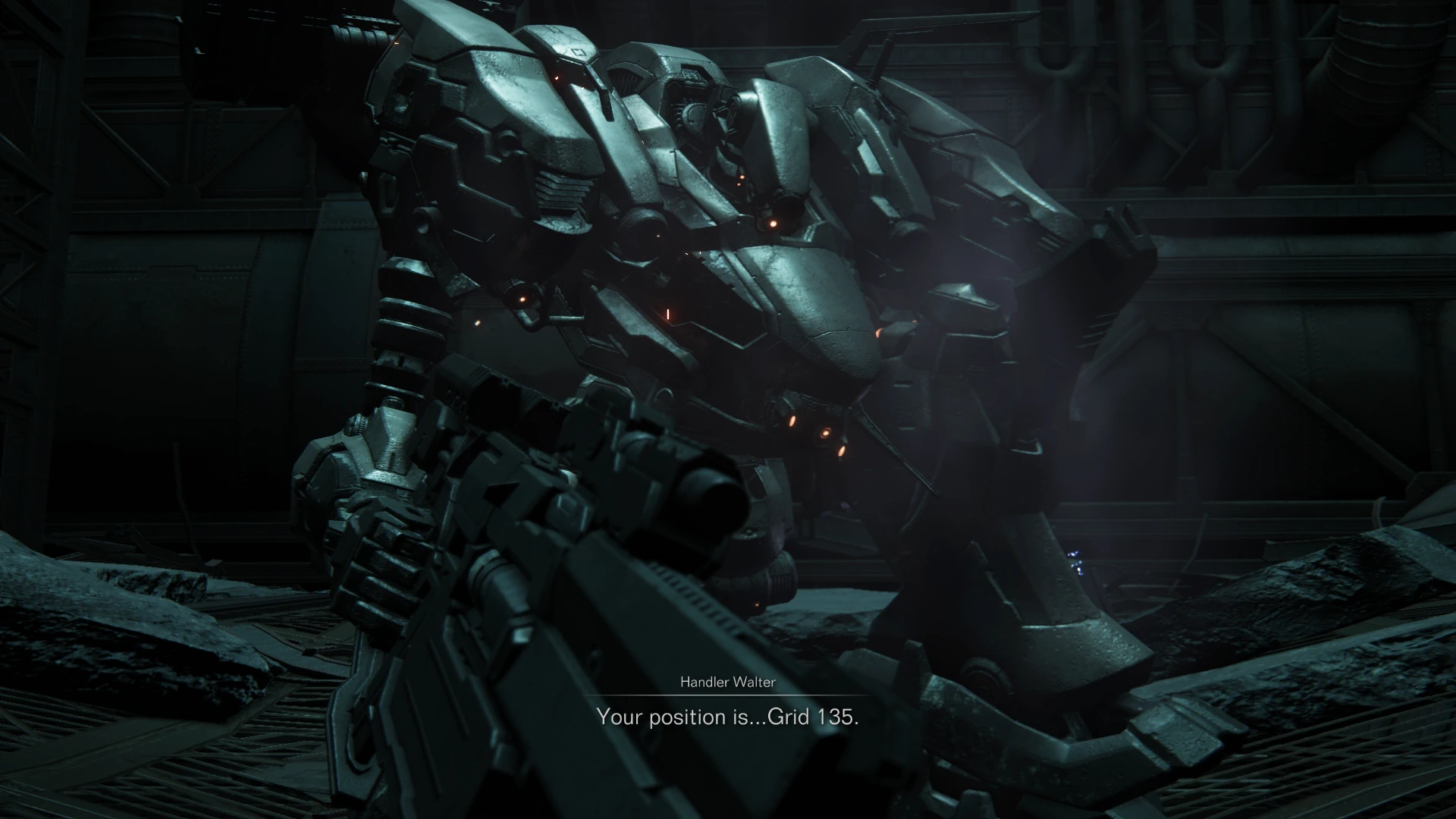
An unlawful entry kicks off the journey of the world's okayest lobotomite.
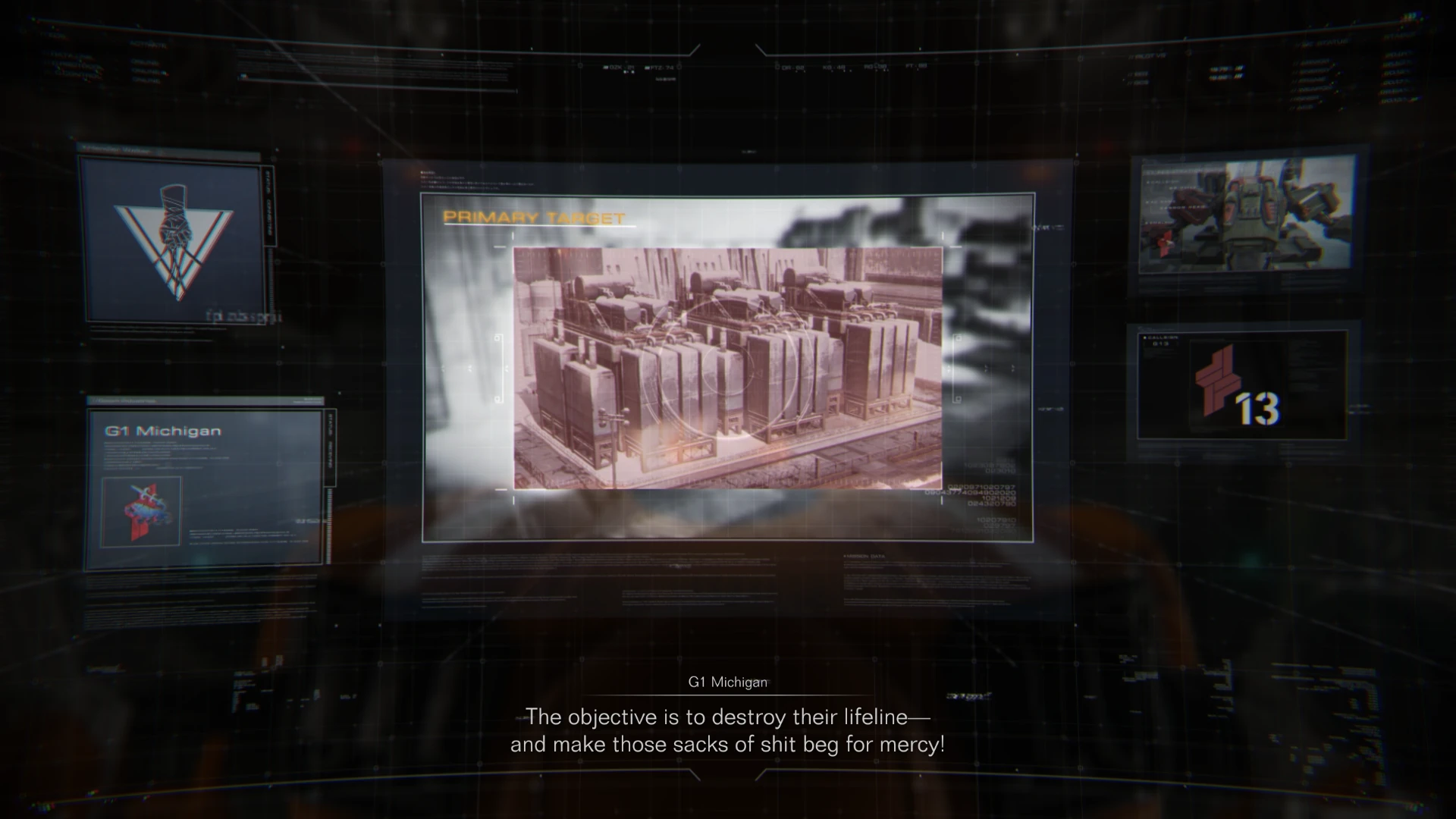
Briefings are often more than just a list of objectives - you learn about the entities within the world and how they view one another within them and more.
Opening right up with the player character, Augmented Human C4-621, making their dramatic illegal entrance from orbit down to the planet Rubicon at the behest of Handler Walter, Armored Core 6 presents a pretty damn solid narrative of corporate greed taken to its extreme, transhumanism, and dehumanisation. In classic series fashion, of course, this isn’t presented primarily through cutscenes, but rather through the briefings they receive before missions, messages received from other characters, dialogue overheard in combat, and through logs scattered across the world. It’s a very immersive method of story-telling which ensures the story never feels like it’s getting in the way of gameplay.
As a whole, the story is probably the best in the series thus far, remaining wholly coherent throughout (unlike some past entries, looking at you AC4) and presenting a varied cast of interesting character with very distinct personalities and backgrounds. It speaks a lot to the strength of their characterisation that you never actually see any of them in-person either, instead only ever seeing their emblem representing them whenever they’re in contact with you. Sorry DaFeng Student Pilot, but you were born into the wrong franchise to be the protagonist you so earnestly wanted to become.
This isn’t just a one-and-done story however; AC6 wants you to play it through multiple times, with 2 endings initially available to the player on their first playthrough, a number of alternate twists appearing in existing missions on their second playthrough, and then a number of entirely new missions and a third ending opening up to the player in the third playthrough. It grants the game a fantastic amount of replay value and offers the player some extra challenge to pit their newfound skill and parts against as they continue to play.
As a closing remark on the story, I’ve really got to give props to From for the amount of situational dialogue they’ve included, from simple extra lines congratulating the player for destroying a trap set for them ahead of time to the insanely specific catch of specific dialogue for players who only decided to complete the training missions once they were on the verge of completing the final mission of the third playthrough, it’s amazing just how much attention to detail was put into this game.
Graphics
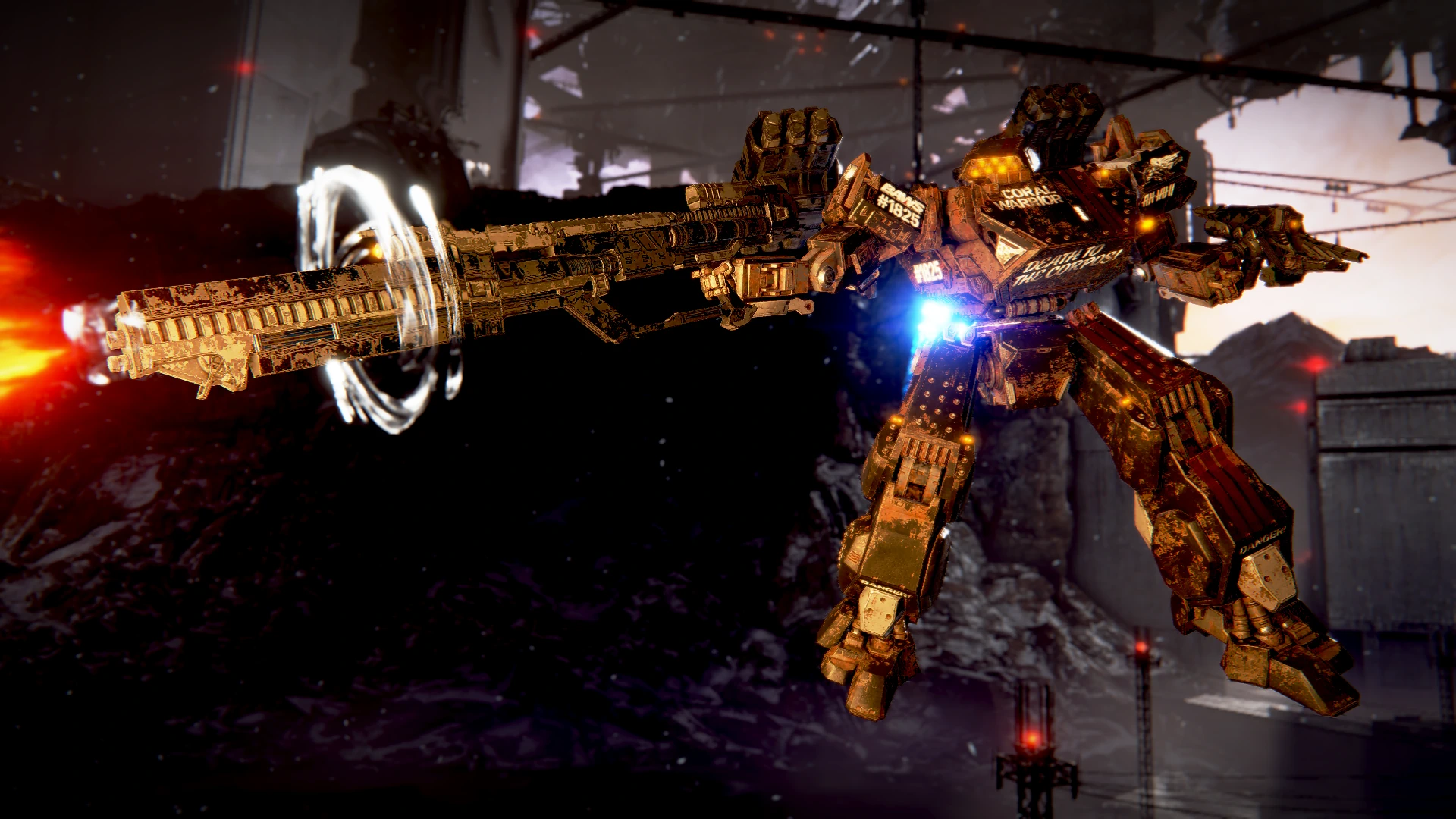
Photo mode lets you show off your coolest ACs...
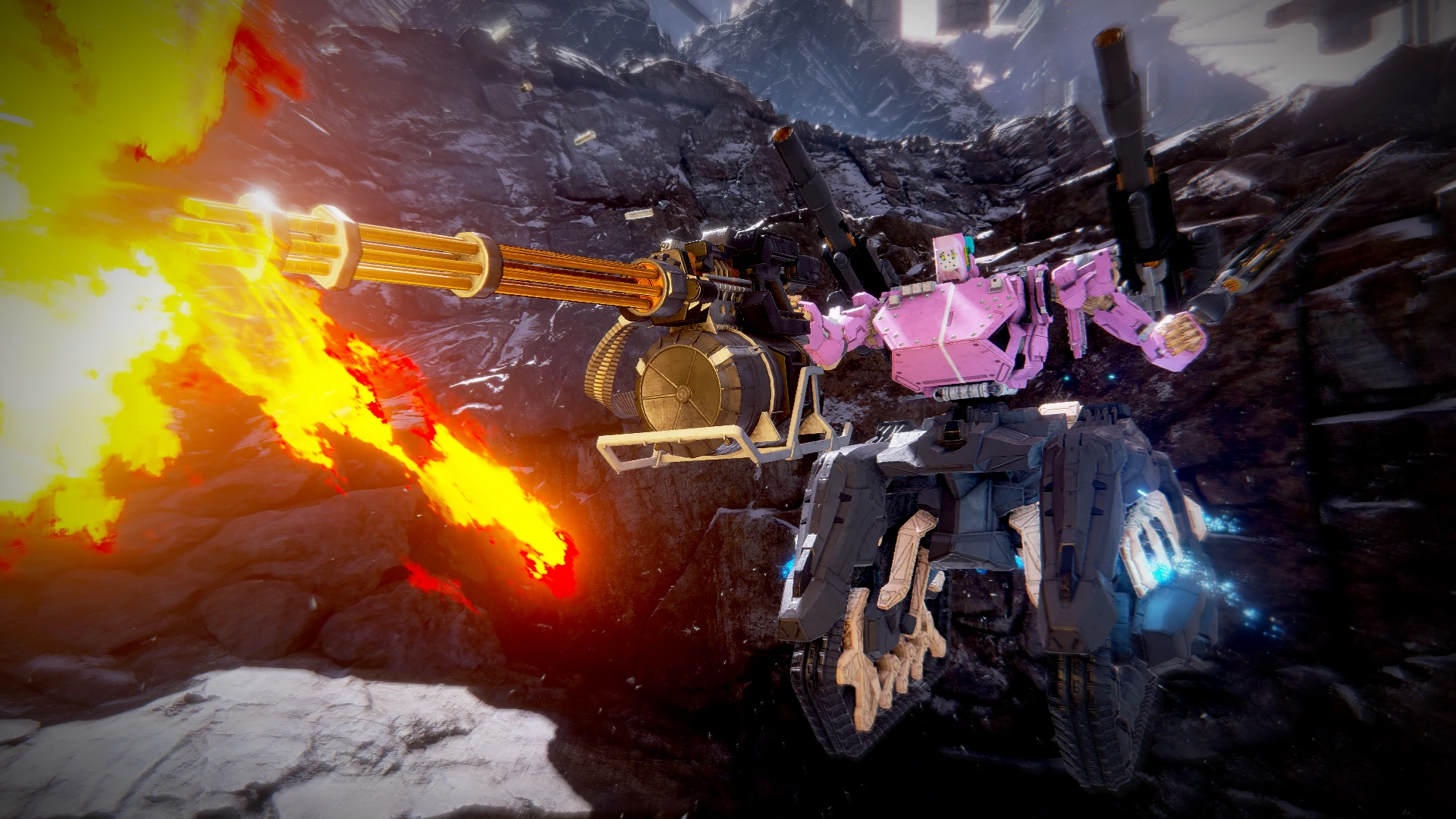
As well as your silliest ACs.
Armored Core 6 is a pretty damn good looking game – Rubicon is a planet with a striking visual style, from its barren icy tundras to wartorn contaminated city ruins to the massive, sprawling Grid networks that hang in the skies, the world is fantastically realised and varied. It’s easy to miss how much attention has been given to even the little details when you’re in your towering AC, as roads are peppered with railings, crosswalks, and abandoned cars, and staircases running up the sides of buildings to little doorways offer a great reference point for the player to see just how colossal a figure they are in the world (approximately 12 metres tall or so, if you want a specific answer). Other great little bits of attention to detail I love are simple things like how depending on which of the three types of generator you use (Internal Combustion, Circulating Current, or Coral), the flames from your AC’s boosters will change colour, or how every single Core part in the game has a different animation for cooling whenever your core expansion ability is on cooldown.
Volumetric fog certainly sees a lot of use throughout the game, often used to great effect to create a gloomy mood in grungy industrial interiors or an aura of unease in eerily still abandoned facilities. The weather effects are similarly well used in turn – when the player sets out to take down the Strider, a blistering sandstorm means the player only sees the daunting silhouette of the massive walking fortress as they close in on it before being fully revealed once the player comes close enough, and later on thick snowfalls in the icefields often precipitate a coming encounter…
Let’s not forget the stars of the show either – the ACs themselves are looking better than ever too. Featuring an ensemble of new and old parts alike, frame parts are covered in great little details such as exhaust ports, access panels, and various other bits that make them feel that bit more real, and player customizable weathering, reflectivity, and lustre offers an insane amount of control just how every surface looks too. All this pays off all the more if you’re like myself and take advantage of the game’s pretty robust Photo Mode, accessible at any time from the pause menu, which will let you take some truly stellar shots of your ACs in all their glory.
What’s more impressive to me however, is that all this visual goodness doesn’t come at any cost to optimization either! My ol’ AMD Radeon RX570 8GB is a mid-range card that was released 7 years ago by now and yet it managed to keep me near enough to 60FPS at 1080p on Ultra for the vast majority of my playthrough. We love to see it.
Audio
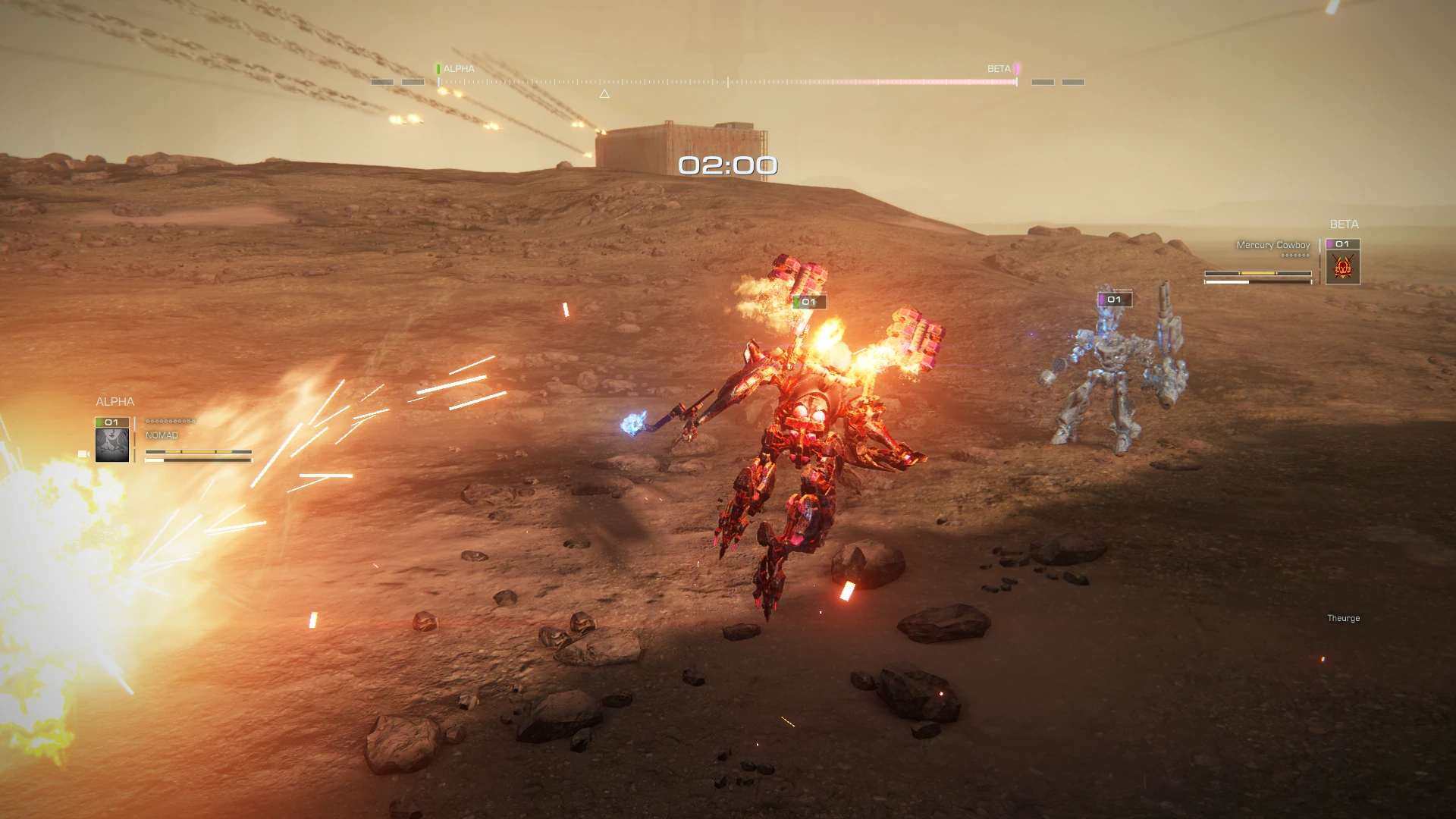
Among existing Armored Core fans, the soundtrack of AC6 has been one of the more contentious topics. Rather than going for a very high energy soundtrack as has been featured in many of the past games, Fires of Rubicon instead opts for a much more atmospheric, moody soundtrack for the most part. While it means we aren’t getting any new FreQuency bangers like ‘Mechanized Memories’ or strangely happy tunes-to-kill-striking-workers-to like AC3’s ‘In My Heart’, we instead get a much more complimentary soundtrack that highlights story moments and further sells the mood the game tries so hard to get across. Deep industrial tones blend with orchestral choirs and synth reminiscent of the work of Vangelis for a very unique OST.
That’s not to say none of the tracks stand out on their own either! Appearing at the boss fight at the end of chapter 1, Ayre’s theme ‘Contact with You’ is exciting and serves as a perfect track for both the moment were the plot really starts to develop and as the backing for what will most certainly be the hardest fight the player has faced in the entire game thus far. There are other tracks I’d love to call attention to, but I don’t want to run the risk of presenting any spoilers, so I’ll simply let you encounter them yourself.
Sounds effects? Oh they’re great, probably the best in the series to date. As mentioned before weapons feel and sound great to use, all the various HUD systems such as lock-ons and warnings have immersive system alert sounds, and your AC’s various movements and the terrain it plows through sound exactly as they feel they should. Gone are the days of 4th gen’s strange racecar sounds whenever you activate overboost – assault boost comes with a nice ol’ nasty belch of igniting rocket engines as you punch forward through the air.
Conclusion
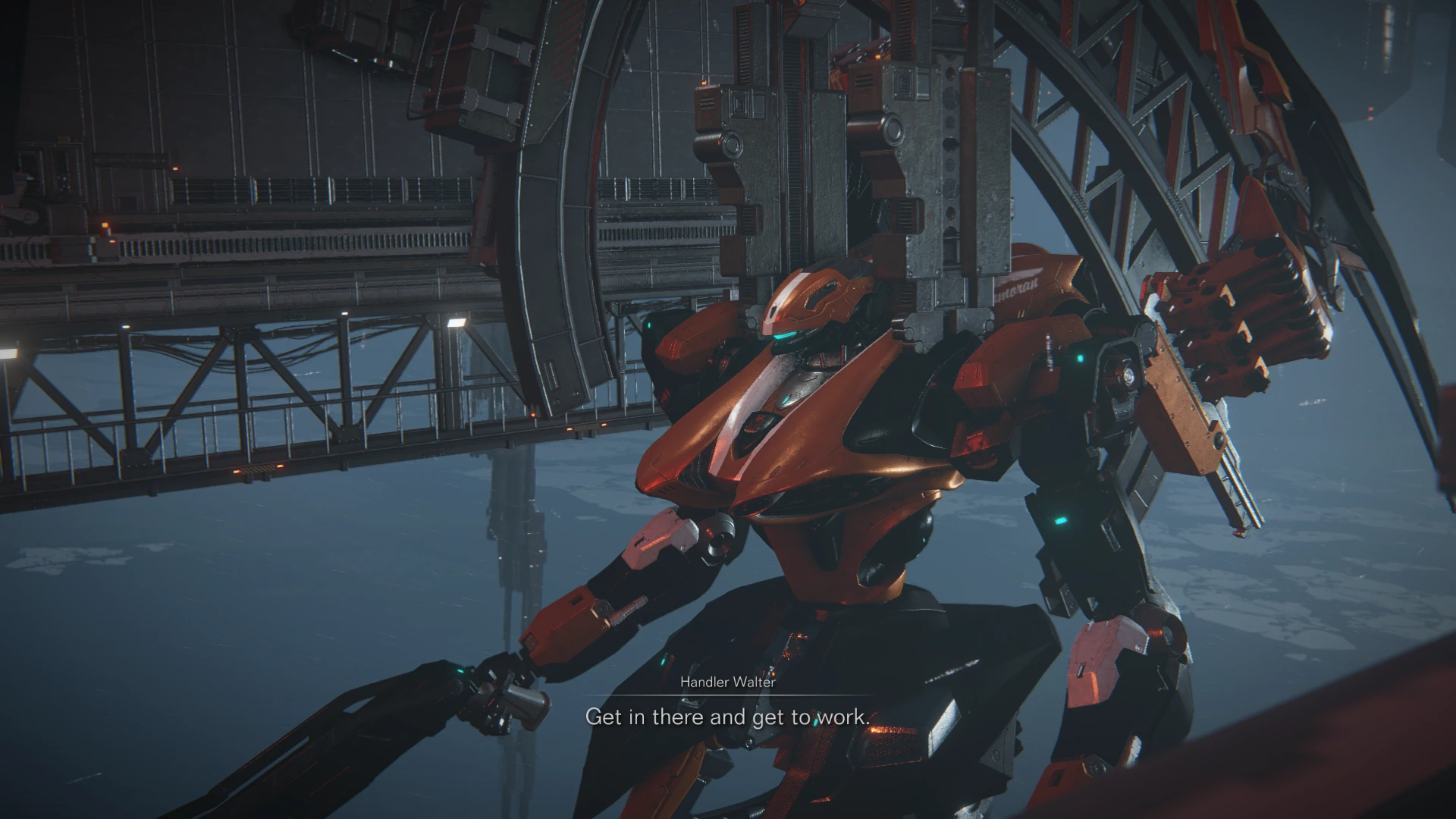
Well. This review certainly went on QUITE a while, but I think it says a lot about AC6 that I felt it necessary to talk so damn much about it. Its fundamentals are so damn solid and offer so much possibility to the player that even though I disliked one of the main new mechanical additions to the game I was still utterly obsessed with it for weeks on end! Is it the perfect AC game? No, but honestly, I don’t think it’s too far off, and having returned from a decade-long hiatus I think that’s a fucking fantastic note to return on, and one that has me very excited for the future of the series.







